Ruby Necklace Plant (Othonna capensis) Care & Propagation Guide
Written by Iris
Dec 03 2022
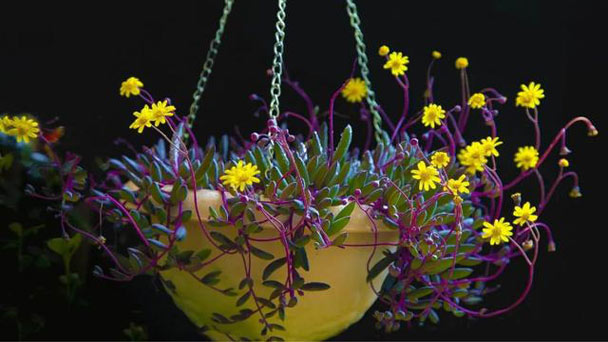
The Ruby Necklace Plant (Othonna capensis) is a fast-growing succulent that is very attractive due to its two-toned stems and leaves. Ruby Necklace Plant also called string of rubies, is a trailing succulent that can also be used in ground cover and rock gardening. The Ruby Necklace Plant is native to South Africa. Like other trailing succulents, Ruby Necklace Plant is very easy to care for. The less we care about them, the better they are. Minimal maintenance and low watering make it the perfect hanging succulent near windowsills.
Ruby Necklace Plant Overview
| Botanical Name | Othonna capensis |
| Common Name | String of rubies, Ruby Necklace Plant, string of pickles, Ruby Necklace Succulent |
| Plant Type | String Succulent |
| Mature Size | 2 inches tall |
| Sun Exposure | Direct sun |
| Soil Type | Well-draining, cactus/succulent soil |
| Soil pH | 6.0-6.5 |
| Bloom Time | Spring, summer, fall |
Where to Grow Ruby Necklace Plant
If you live in a colder environment, where temperature can go below 20 °F (-6.7 °C), You should plant Ruby Necklace Plant in a pot (better with a drainage hole). Because Ruby Necklace Plant is not cold hardy and you'll be able to bring it inside in winter. Ruby Necklace Plant grows well in a brighter area where it gets about 4 to 6 hours of sunlight. But keep it away from direct sunlight in very hot months.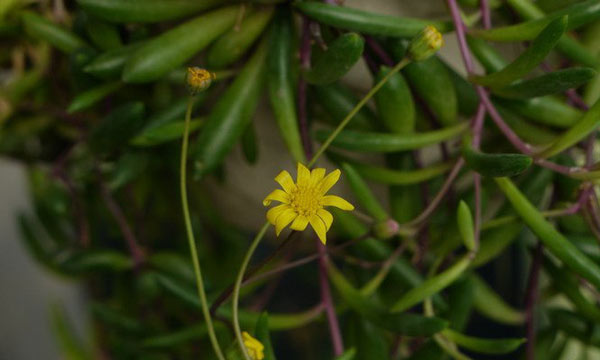
How to Propagate Ruby Necklace Plant (Othonna capensis)
The ruby necklace plant is similar to other succulents that are easy to propagate. Ruby Necklace Plant propagation can only be accomplished with stems, hydrotherapy and seeds. When breeding is successful, you can sell or give the othonna capensis to your loved ones. In addition, you can sell a large Othonna Capensis. The best time to breed Ruby Necklace Plant is spring and autumn.Ruby Necklace Plant Propagation with Seeds
Ruby necklace plant (Othonna capensis) seed propagation can be done, and growing Ruby Necklace Plant from seeds is a very simple process.Seed pods are located at the tips of completely dried flowers and should be removed carefully.
Sterilize dry soil in the microwave for 90 seconds. This will kill harmful bacteria.
Dry the succulent seeds of the Ruby Necklace Plant and plant them under the top layer of the soil.
Place in indirect sunlight or growth light. Cover the soil with a plastic or glass lid to retain moisture.
After a month, it will grow young saplings that can be transferred to a larger pot.
Ruby Necklace Plant Propagation with Stem Cuttings
The Ruby Necklace Plant (Othonna capensis) is very easy to propagate by stems.Just cut with a clean, sterilized cutting tool and let it harden for an hour or two.
Use rooting hormone when potting in soil.
During reproduction through the stem, fragile leaves may be shed from the stem.
Ruby Necklace Plant Propagation with Leaves
Spreading the Ruby Necklace Plant through leaves is very difficult and almost impossible.However, if you find broken healthy leaves with small stems, throw them into the same pot.
Ruby Necklace Plant Propagation with Division
Ruby Necklace Plant (Othonna capensis) propagation by roots is also a simple process.When the Ruby Necklace Plant has long branching stems, you might notice that aerial rooting occurs after some intervals in the stems. From then on, do a clean cut on the Ruby Necklace Plant 1 inch below the root using a clean sterilized cutting tool, and wait for the callus for 1 to 2 hours before potting it into damp soil. Put it in indirect bright sunlight.
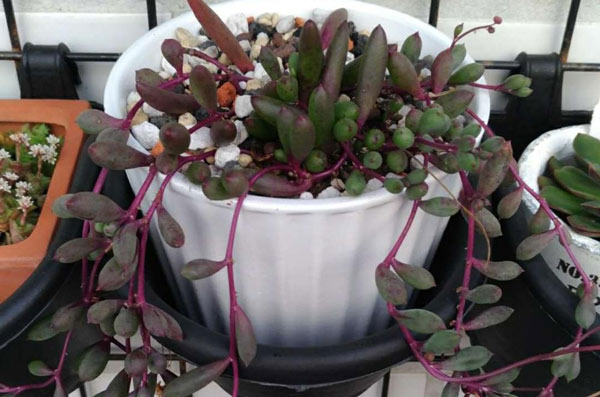
How to Care for Ruby Necklace Plant (Othonna capensis)
Ruby Necklace Plant Light Requirements
The Leaves on the Ruby Necklace Plant (Othonna capensis) will also start to turn purple if you give the Ruby Necklace Plant continuous bright light. Four to six hours in the morning sun, bright light continues in indirect light. Avoid afternoon sun or even bright light in summer. The Ruby Necklace Plant can even thrive in low light conditions, making it a perfect hanging succulent, but the stem will be green in color. The lowest lightning conditions damage the Ruby Necklace Plant , e.g. the space between the leaves increases and the strand looks weaker due to stretching and lack of sunlight. The best window for Ruby Necklace Plant is the southwest window.Ruby Necklace Plant Soil Care
Ruby Necklace Plant naturally grows in South Africa where the porous soil gives them well drainage. So you'll also need the same type of well drainage soil for it to grow well. If you need to make your soil, you can check my in-depth guide on preparing the perfect DIY succulent soil for containers. You can also get the pre-mixed gritty mix succulent soil from amazon.Ruby Necklace Plant Watering
Ruby Necklace Plant requires the typical succulent watering schedule. It is best to water once the soil is totally dry. Otherwise, the roots of Ruby Necklace Plant may rot in wet soil. You can check the soil by putting your finger into the soil about 2.5 inches deep. Or, typically water after 4 to 7 days, depending on your environment conditions. Ruby Necklace Plant is a winter dormant plant and does not require much water in this season, except in excessively dry conditions.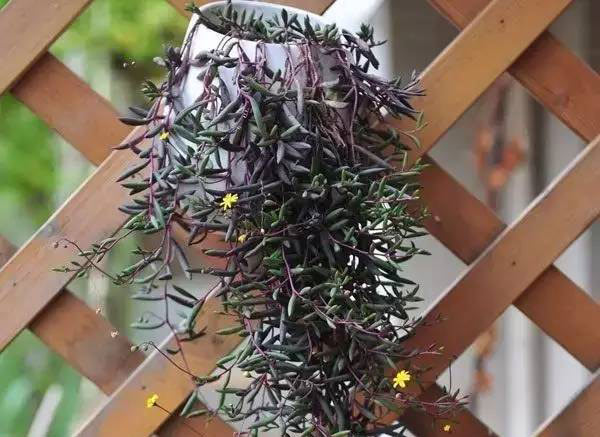
Ruby Necklace Plant Temperature & Humidity Care
The Ruby Necklace Plant is not a cold weather succulent and does best in warmer temperatures. Never let your Ruby Necklace Plant sit in temperatures below 50 degrees Fahrenheit (10 degrees Celsius) for extended periods of time. When grown indoors, a Ruby Necklace succulent does well in typical household temperature and humidity levels. Avoid placing your string of rubies next to cold or drafty windows during extreme winter temperatures.Ruby Necklace Plant Fertilizer Care
The best thing about the ruby necklace succulent plant is that it is efficient in fertilization. Ruby Necklace Plant doesn’t need a lot of fertilization because what matters to it is the place where he grows. For fertilization, Ruby Necklace Plant only needs once or twice a year. This is because the Ruby Necklace Plant Succulent ornamental plants are resistant to plant pests.Excessive fertilization will cause Ruby Necklace Plant to grow abnormally. The stems, which are red purple in color, usually bloom in spring, which is between May and June. During the blooming season, Othonna capensis requires moderate amounts of water to keep plants and flowers fresh. If there is too much water, plants will actually cause root death. So, the best time to water the Ruby Necklace Plant Succulent is when it’s dry, but don’t water every day.
Ruby Necklace Plant Pests & Diseases Care
Watch out for common sap-sucking houseplant pests such as mealybugs and scale on your string of rubies. Regularly inspecting the succulent and catching any pests early is the best way to prevent more serious infestations. Treat affected plants with rubbing alcohol, neem oil, or insecticidal soap to get rid of unwanted pests.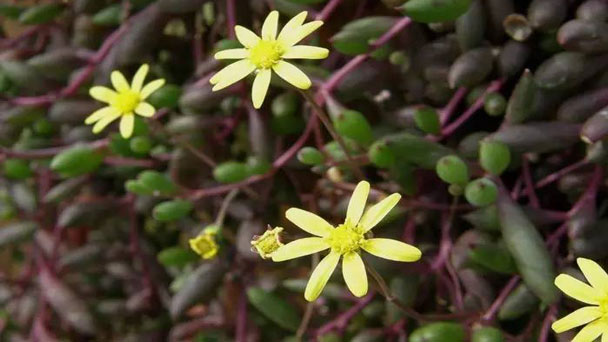
String of Rubies Plant (Othonna Capensis) Problems Indoors
The root-rot disease, dropping leaves, shriveled leaves, diseases, and pests are a few examples of the problems that the string of rubies plant (Othonna capensis) faces indoors due to cultural mistakes. Continue reading to learn more about these issues, as well as possible solutions.
String of Rubies Plant Dying
Any number of factors can cause the String of Rubies Plant to die. Root-rot disease, which is exacerbated by soggy soil, is one of the reasons String of Rubies is perishing.
Remove the String of Ruby from its pot, then look at the roots. Root rot disease is indicated by brown-black roots. Remove them by cutting them off, then apply a fungicidal solution to the sound roots.
Repot the plant in a fresh container with new potting soil. Keep the soil dry for a while before starting to water again. Learn more about the root-rot disease and how to treat it.
Make sure the soil is free-draining and the pot for your String of Rubies Plant has a drainage hole in order to prevent getting soggy soil. This plant loves the soil for succulents.
Additionally, try to avoid overwatering, particularly during the colder months when the plant doesn't need as much water as it does when it is actively growing because there isn't much growth going on.
String of Rubies Plant Dropping Leaves
Three factors may be to blame for the String of Rubies Plant dropping its leaves. Watering with extremely cold water is one potential cause of the String of Rubies Plant losing leaves.
To prevent shocking the plant, water this tropical plant with water that is at room temperature.
Underwatering is a secondary explanation for the String of Rubies Plant's leaf loss. Water the plant sparingly, only soaking the top 2-3 inches. of soil to dry out between waterings but never allow the soil ball to dry out completely.
Soggy soil is a third reason why String of Rubies Plants lose their leaves.
Make sure your String of Rubies Plant's pot has a drainage hole and that the soil is free-draining to prevent soggy soil. Additionally, as growth is minimal during the cold season, reduce watering volume and frequency.
String of Rubies Plant Brown, Dry Leaf Spots
Underwatering is the cause of the brown, dry leaf spots on the String of Rubies plant.
During the growing season, give the String of Rubies Plant only the top 2-3 inches of water. of the soil to dry out between waterings but do not allow the soil to dry out completely.
String of Rubies Plant Shrivelled (wilted and Discolored) Leaves
There are two potential causes of the shriveled (wilted and discolored) leaves on the String of Rubies plant.
One possible reason for shrivelled leaves in String of Rubies Plant is overwatering during the cold season which will result in soggy soil.
Reduce the amount and frequency of watering during the colder months and keep the soil just moist. The plant grows very little during the cold season, so it uses little water.
Underwatering during the growing season is the second potential explanation for the shriveled leaves of the String of Rubies Plant.
Throughout the growing season, water the plant sparingly while letting the top 2-3 in. of the soil to dry out between waterings but do not allow the soil to dry out completely.
String of Rubies Plant Rotting Base and Stem Collapse
Basal stem-rot disease, which is caused by excessive moisture, is indicated by the rotting base and stem collapse of the String of Rubies plant.
Remove the infected components and use the upper stem to grow new plants. In the future, water your String of Rubies Plant less frequently during the winter.
String of Rubies Plant Elongated (Leggy) Stems
Overwatering causes the String of Rubies Plant's leggy (extended) stems during the cold season. Water less and keep the soil just moist.
Too little light is the cause of elongated (leggy) stems that appear during the growing season. Bright areas with some direct sunlight are ideal for the growth of the String of Rubies Plant. In an effort to reach the source of light, a plant that receives insufficient light will develop weak, elongated (leggy) stems.
String of Rubies Plant Diseases
Powdery mildew and leaf spot diseases are examples of the String of Rubies plant diseases. Keep the afflicted plant isolated to stop the disease from spreading to other houseplants, and then treat it as needed.
String of Rubies Plant Pests
String of Rubies Plant pests; mealy bugs, aphids, scale insects and spider mites. Isolate the afflicted plant to stop the spread of the pests to other houseplants, and then treat it as needed.
Ruby Necklace Plant FAQ
Is Ruby Necklace Plant Poisonous?
Ruby Necklace Plant is a non-poisonous and is considered a safe succulent plant.Is Ruby Necklace Plant Plant a Xeric Plant?
Ruby Necklace Plant is a plant that can grow well in xeric gardens. Xeric gardening is a landscape model that allows one to grow a variety of plants without having to add water from time to time. Ruby Neklace Succulent is suitable for planting in xeric gardens because it is a plant that grows in dry and semi-arid places. This means that he does not need much water for growth. Ruby Necklace Plant can withstand drought without the need for daily watering. watering only needs to be done when the soil is completely dry. Even then, only a little watering. Another reason why Ruby Necklace Plant is suitable for planting in xeric gardens is because of its appeal. This Ruby Necklace Plant plant blends well with other flower plants. So, the existence of a Ruby Necklace Plant is no stranger to these plants.Is Ruby Necklace Plant Invasive?
In its native settings, Ruby Necklace Plant plants grow with wild abandon. If you live in areas where the plant is winter hardy, be careful not to allow Othonna to ramble off freely. Ruby Necklace Plant has a rapid growth rate. Naturally, in settings where the Ruby Necklace Plant will die back during the winter it is not invasive. Likewise, if you keep it as a houseplant it will not have the opportunity to be invasive.Read Next:
String of Turtles Plant (Peperomia Prostrata) Care Guide
String of Pearls Plant Care & Propagation
String of Hearts Plant Care & Propagation
20 Popular Vine Plants Indoor To Grow
11 Best String of Succulent Varieties as Hanging Plants
Latest Updated
- Benefits of Bugleweed - 7 Science-backed Health Benefits
- Bugleweed Dangers & Side Effects - Is It Poisonous?
- How to Plant Evergreen Trees - What You Should Know
- When to Plant Evergreens - Grow Guide for Evergreen Trees
- 12 Wonderful Evergreen Shrubs for Your Garden
- 12 Popular Evergreen Plants with Pictures for Beginners
- When And How To Prune A Lilac Bush Like a Pro
- How to Grow & Care for Lilac Vine (Hardenbergia Violacea)
- Japanese Lilac Tree (Syringa Reticulata) Care & Propagation Guide
- Shumard Oak Pros and Cons - What to Know
Popular Articles
- Winter maintenance of Antirrhinum Majus
- How to Grow Terminalia Mantaly Tree
- How to Grow and Care for Crossostephium Chinense
- How to grow Antirrhinum Majus in spring
- Peristeria Elata (Dove Orchid) Profile: Info & Care Guide
- Underwatered Snake Plant (Sansevieria Trifasciata) - Signs And How To Fix
- How to Care for Brazilian Jasmine Plant (Mandevilla Sanderi)
- How to Grow & Care for Graptopetalum Purple Delight in Summer
- Rosa Chinensis (China Rose): Plant Growing & Care Tips
- How to Care for Baby Sun Rose (Aptenia Cordifolia)